Ensuring a Stable Domestic Copper Supply: Arizona's Production
- United States | 28 August 2022

Copper, a highly versatile metal, is experiencing a surge in demand due to its essential role in various industries and its significance in the green revolution. As countries strive to achieve their global climate change ambitions, the need for copper has skyrocketed, particularly in the modernization of power generation and transmission infrastructure to accommodate renewable energy sources like solar PV, onshore and offshore wind, nuclear power, hydropower, and the rapid electrification of transportation with electric vehicles (EVs).
Projections indicate that copper demand will continue to rise over the next 25 years. From the current 25 million metric tons, demand is expected to reach approximately 50 million tons by 2035 and a record-high level of 53 million tons by 2050. Meeting this demand is crucial for achieving net-zero emissions by 2050. Experts agree that substitution and recycling alone will not be sufficient to fulfill the requirements of EVs, power infrastructure, and renewable energy generation. Massive new supply is needed to bridge the supply-demand gap.
The United States, being the fifth-largest copper producer globally and possessing the sixth-largest copper reserves of 48 million tons, has a unique opportunity to address this impending supply-demand imbalance. Stuart McDonald, the president and CEO of Taseko Mines, a North American mining company, points out that many copper reserves and projects around the world are located in politically and socially unstable jurisdictions. Currently, almost 40% of copper production comes from Chile and Peru, both experiencing political and social challenges.
Despite the global economic uncertainties of recent years, copper production in the US has remained relatively stable. After a 4.8% decline in 2020 due to the pandemic, the country’s red metal production rebounded by 2.5% in 2021 to reach 1.2 million tons. This recovery was supported by increased output from major producers like Freeport-McMoRan and Rio Tinto. Together, these two companies accounted for 66.8% of total US copper production in 2021, producing 821,000 tons, up from 783,300 tons in the previous year.
Freeport-McMoRan witnessed a 3% growth in copper production in 2021, mainly attributed to the ramp-up of operations at the Lone Star mine in Arizona, which began in 2020. Joshua Olmsted, the president and COO for the Americas at Freeport, emphasizes the significance of the Lone Star project, stating that the company initially anticipated an annual production of about 200 million pounds of copper. However, the project’s success has increased the production estimate to 300 million pounds. Freeport is currently focusing on developing oxide resources while planning for the long term.
Arizona, where the Lone Star mine is located, hosts several other top US and global copper producers, including Capstone Mining Corp, Grupo Mexico, and KGHM. Additionally, there are promising development-stage projects in the region that could soon contribute to meeting the growing global copper demand. One notable project is Resolution Copper, a joint venture between mining giants Rio Tinto (55%) and BHP (45%). Situated near Superior in Arizona’s Copper Triangle, Resolution is a significant untapped copper deposit, estimated to contain 1.787 billion tons of copper resources with an average grade of 1.5% copper. Once operational, it is expected to be the largest copper mine in North America, capable of supplying up to 25% of US copper demand annually and generating numerous jobs and economic benefits.
However, the permitting process for projects on federal land in the US, including Resolution Copper and Rosemont, has been lengthy and complex, presenting challenges to securing a domestic copper supply chain and meeting climate commitments. Resolution Copper, despite the investments of billions of dollars by Rio Tinto and BHP, is yet to produce any copper due to ongoing permitting challenges. The project’s Environmental Impact Statement (EIS) was published in January 2021 but later rescinded by the incoming Biden administration in March of the same year. Andrew Lye, the project director at Rio Tinto, explains that they are in the process of republishing the EIS to move the project forward.
Hudbay Minerals, a Canadian mining company, has also faced permitting delays for its major copper projects in Arizona. However, the company recently unveiled a Preliminary Economic Assessment (PEA) for its Copper World Complex, including deposits at the Copper World mine and the Rosemont asset. The assessment indicates a substantial economic value and potential for meeting copper needs. While the Copper World project is progressing without requiring federal permits for the first phase, Rosemont, the second phase, has faced setbacks due to environmental concerns.
Another project that could contribute to US copper output in the near future is Taseko Mines’ Florence Copper asset, which is in the final stages of permitting. Florence Copper utilizes an innovative in-situ recovery process, minimizing environmental impact and reducing surface disturbance. By injecting a diluted sulphuric acid solution into fractured ore, copper can be recovered in solution and processed on-site. This technology allows the production of pure refined copper without the need for extensive further processing.
The US, particularly Arizona, possesses significant geological potential and an investor-friendly environment to address the copper supply-demand imbalance. However, the lengthy permitting process for projects on federal land raises concerns about the nation’s ability to secure a domestic supply chain, rebuild infrastructure, and achieve climate commitments. Policymakers need to take decisive action to improve regulations and legislation, ensuring that domestic mining is economically viable while upholding environmental and social standards.








